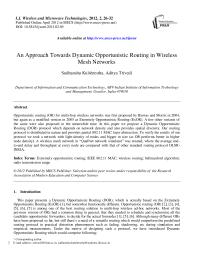An Approach Towards Dynamic Opportunistic Routing in Wireless Mesh Networks
Автор: Sudhanshu Kulshrestha, Aditya Trivedi
Журнал: International Journal of Wireless and Microwave Technologies(IJWMT) @ijwmt
Статья в выпуске: 2 Vol.2, 2012 года.
Бесплатный доступ
Opportunistic routing (OR) for multi-hop wireless networks was first proposed by Biswas and Morris in 2004, but again as a modified version in 2005 as Extremely Opportunistic Routing (ExOR). A few other variants of the same were also proposed in the meanwhile time. In this paper we propose a Dynamic Opportunistic Routing (DOR) protocol which depends on network density and also provides spatial diversity. Our routing protocol is distributed in nature and provides partial 802.11 MAC layer abstraction. To verify the results of our protocol we took a network with light-density of nodes and bigger in size (as OR performs better in higher node density). A wireless mesh network in “QualNet network simulator” was created, where the average end-to-end delay and throughput at every node are compared with that of other standard routing protocol OLSR-INRIA.
Extremely opportunistic routing, IEEE 802.11 MAC, wireless routing, bellmanford algorithm, radio transmission range
Короткий адрес: https://sciup.org/15012796
IDR: 15012796
Список литературы An Approach Towards Dynamic Opportunistic Routing in Wireless Mesh Networks
- S. Biswas and R. Morris, “ExOR: opportunistic multi-hop routing for wireless networks,” Computer Communication Review, vol. 35, no. 4, p. 133, 2005.
- E. Rozner, J. Seshadri, Y. Mehta, and L. Qiu, “Simple opportunistic routing protocol for wireless mesh networks,” in Wireless Mesh Networks, 2006. WiMesh 2006. 2nd IEEE Workshop on. IEEE, 2007, pp. 48–54.
- X. Mao, X. Li, W. Song, P. Xu, and K. Moaveni-Nejad, “Energy efficient opportunistic routing in wireless networks,” in Proceedings of the 12th ACM international conference on Modeling, analysis and simulation of wireless and mobile systems. ACM, 2009, pp. 253–260.
- M. Naghshvar and T. Javidi, “Opportunistic routing with congestion diversity and tunable overhead,” in Communications, Control and Signal Processing (ISCCSP), 2010 4th International Symposium on. IEEE, 2010, pp. 1–6.
- Y. Li, Y. Liu, L. Li, and P. Luo, “Local scheduling scheme for opportunistic routing,” in Wireless Communications and Networking Conference, 2009. WCNC 2009. IEEE. IEEE, 2009, pp. 1–6.
- S. Chachulski, M. Jennings, S. Katti, and D. Katabi, “Trading structure for randomness in wireless opportunistic routing,” in Proceedings of the 2007 conference on Applications, technologies, architectures, and protocols for computer communications. ACM, 2007, pp. 169–180.
- A. Bhorkar, B. Rao, M. Naghshvar, and T. Javidi, “An adaptive opportunistic routing scheme for wireless ad-hoc networks,” in Information Theory, 2009. ISIT 2009. IEEE International Symposium on. IEEE, 2009, pp. 2838–2842.
- C. Luk, W. Lau, and O. Yue, “An analysis of opportunistic routing in wireless mesh network,” in Communications, 2008. ICC’08. IEEE International Conference on. IEEE, 2008, pp. 2877–2883.
- D. Couto, D. Aguayo, J. Bicket, and R. Morris, “A high-throughput path metric for multi-hop wireless routing,” Wireless Networks, vol. 11, no. 4, pp. 419–434, 2005.
- Q. Simulator, “Scalable Network Technologies,” Inc.[Online]. Available: www. qualnet. com.
- I. Alocci, S. Murphy, A. Nafaa, and J. Murphy, “Development of an IEEE 802.11 s Simulation Model for QualNet.”


